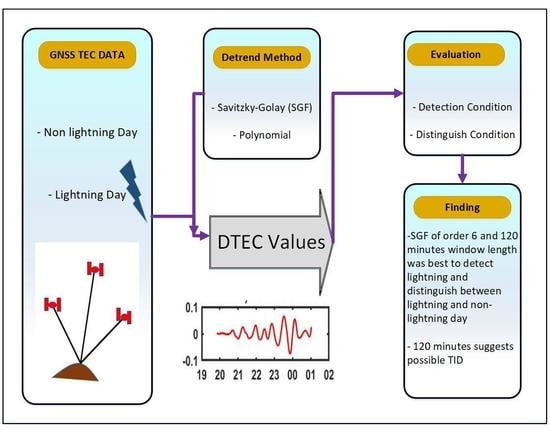Evaluating Total Electron Content (TEC) Detrending Techniques in Determining Ionospheric Disturbances during Lightning Events in A Low Latitude Region
Abstract
:1. Introduction
2. Materials and Methods
2.1. Detrending Methods
2.1.1. Savitzky–Golay Filter
2.1.2. Polynomial Filtering
2.2. GNSS Data
2.3. Thunderstorm/Lightning Data
2.4. Selection Criteria
3. Results
3.1. First Set of Days (Quiet Days before Lightning Events)
3.1.1. 9th July
3.1.2. 10th July
3.1.3. 11th July
3.2. Second Set of Days (Lightning Days)
3.2.1. 17th July
3.2.2. 18th July
3.2.3. 19th July
3.3. Third Set of Days (Quiet Days after Lightning Events)
3.3.1. 1st August
3.3.2. 2nd August
3.3.3. 3rd August
4. Discussion
5. Conclusions
Author Contributions
Funding
Data Availability Statement
Acknowledgments
Conflicts of Interest
References
- Maletckii, B.; Yasyukevich, Y.; Vesnin, A. Wave signatures in total electron content variations: Filtering problems. Remote. Sens. 2020, 12, 1340. [Google Scholar] [CrossRef] [Green Version]
- Cherniak, I.; Zakharenkova, I. Large-scale traveling ionospheric disturbances origin and propagation: Case study of the december 2015 geomagnetic storm. Space Weather 2018, 16, 1377–1395. [Google Scholar] [CrossRef]
- Ray, S.; Roy, B.; Paul, K.S.; Goswami, S.; Oikonomou, C.; Haralambous, H.; Chandel, B.; Paul, A. Study of the effect of 17–18 March 2015 geomagnetic storm on the Indian longitudes using GPS and C/NOFS. J. Geophys. Res. Space Phys. 2017, 122, 2551–2563. [Google Scholar] [CrossRef]
- Belehaki, A.; Kutiev, I.; Marinov, P.; Tsagouri, I.; Koutroumbas, K.; Elias, P. Ionospheric electron density perturbations during the 7–10 March 2012 geomagnetic storm period. Adv. Space Res. 2017, 59, 1041–1056. [Google Scholar] [CrossRef]
- Kong, J.; Yao, Y.; Zhou, C.; Liu, Y.; Zhai, C.; Wang, Z.; Liu, L. Tridimensional reconstruction of the Co-Seismic Ionospheric Disturbance around the time of 2015 Nepal earthquake. J. Geod. 2018, 92, 1255–1266. [Google Scholar] [CrossRef]
- Liu, Y.; Jin, S. Ionospheric Rayleigh wave disturbances following the 2018 Alaska earthquake from GPS observations. Remote. Sens. 2019, 11, 901. [Google Scholar] [CrossRef] [Green Version]
- Polyakova, A.S.; Perevalova, N.P. Investigation into impact of tropical cyclones on the ionosphere using GPS sounding and NCEP/NCAR Reanalysis data. Adv. Space Res. 2011, 48, 1196–1210. [Google Scholar] [CrossRef]
- Yu, S.; Liu, Z. The ionospheric condition and GPS positioning performance during the 2013 tropical cyclone Usagi event in the Hong Kong region. Earth Planets Space 2021, 73, 1–16. [Google Scholar] [CrossRef]
- Yang, Z.; Liu, Z. Observational study of ionospheric irregularities and GPS scintillations associated with the 2012 tropical cyclone Tembin passing Hong Kong. J. Geophys. Res. Space Phys. 2016, 121, 1–13. [Google Scholar] [CrossRef]
- Lay, E.H.; Shao, X.M.; Kendrick, A.K.; Carrano, C.S. Ionospheric acoustic and gravity waves associated with midlatitude thunderstorms. J. Geophys. Res. Space Phys. 2015, 120, 6010–6020. [Google Scholar] [CrossRef]
- Rahmani, Y.; Alizadeh, M.M.; Schuh, H.; Wickert, J.; Tsai, L.-C. Probing vertical coupling effects of thunderstorms on lower ionosphere using GNSS data. Adv. Space Res. 2020, 66, 1967–1976. [Google Scholar] [CrossRef]
- Ogunsua, B.O.; Srivastava, A.; Bian, J.; Qie, X.; Wang, D.; Jiang, R.; Yang, J. Significant day-time ionospheric perturbation by thunderstorms along the West African and Congo sector of equatorial region. Sci. Rep. 2020, 10, 8466. [Google Scholar] [CrossRef]
- Amin, M.M. Influence of Lightning on Electron Density Variation in the Ionosphere Using WWLLN Lightning Data and GPS Data. Master’s Thesis, University of Cape Town, Cape Town, South Africa, 2015. [Google Scholar]
- Tang, L.; Chen, W.; Chen, M.; Osei-Poku, L. Statistical observation of thunderstorm-induced ionospheric gravity waves above low-latitude areas in the northern hemisphere. Remote. Sens. 2019, 11, 2732. [Google Scholar] [CrossRef] [Green Version]
- Liu, T.; Yu, Z.; Ding, Z.; Nie, W.; Xu, G. Observation of Ionospheric Gravity Waves Introduced by Thunderstorms in Low Latitudes China by GNSS. Remote. Sens. 2021, 13, 4131. [Google Scholar] [CrossRef]
- Jardim, R.; Morgado-Dias, F. Savitzky–Golay filtering as image noise reduction with sharp color reset. Microprocess. Microsyst. 2020, 74, 103006. [Google Scholar] [CrossRef]
- Chakraborty, M.; Das, S. Determination of signal to noise ratio of electrocardiograms filtered by band pass and Savitzky-Golay filters. Procedia Technol. 2012, 4, 830–833. [Google Scholar] [CrossRef] [Green Version]
- Coster, A.J.; Goncharenko, L.; Zhang, S.R.; Erickson, P.J.; Rideout, W.; Vierinen, J. GNSS observations of ionospheric variations during the 21 August 2017 solar eclipse. Geophys. Res. Lett. 2017, 44. [Google Scholar] [CrossRef] [Green Version]
- Savitzky, A.; Golay, M.J.E. Smoothing and differentiation of data by simplified least squares procedures. Anal. Chem. 1964, 36, 1627–1639. [Google Scholar] [CrossRef]
- Ji, S.; Chen, W.; Wang, Z.; Xu, Y.; Weng, D.; Wan, J.; Fan, Y.; Huang, B.; Fan, S.; Sun, G.; et al. A study of occurrence characteristics of plasma bubbles over Hong Kong area. Adv. Space Res. 2013, 52, 1949–1958. [Google Scholar] [CrossRef]
- Tang, L.; Chen, W.; Louis, O.-P.; Chen, M. Study on seasonal variations of plasma bubble occurrence over Hong Kong area using GNSS observations. Remote Sens. 2020, 12, 2423. [Google Scholar] [CrossRef]
- Zhang, S.-R.; Coster, A.J.; Erickson, P.J.; Goncharenko, L.P.; Rideout, W.; Vierinen, J. Traveling ionospheric disturbances and ionospheric perturbations associated with solar flares in September 2017. J. Geophys. Res. Space Phys. 2019, 124, 5894–5917. [Google Scholar] [CrossRef] [Green Version]
- Afraimovich, E.L.; Kosogorov, E.A.; Leonovich, L.A.; Palamartchouk, K.S.; Perevalova, N.P.; Pirog, O.M. Determining parameters of large-scale traveling ionospheric disturbances of auroral origin using GPS-arrays. J. Atmos. Sol. Terr. Phys. 2000, 62, 553–565. [Google Scholar] [CrossRef]
- Liu, J.; Zhang, D.-H.; Coster, A.J.; Zhang, S.-R.; Ma, G.-Y.; Hao, Y.-Q.; Xiao, Z. A case study of the large-scale traveling ionospheric disturbances in the eastern Asian sector during the 2015 St. Patrick’s Day geomagnetic storm. Annales Geophysicae 2019, 37, 673–687. [Google Scholar] [CrossRef] [Green Version]
- Freeshah, M.; Zhang, X.; Chen, J.; Zhao, Z.; Osama, N.; Sadek, M.; Twumasi, N. Detecting ionospheric TEC disturbances by three methods of detrending through dense CORS during a strong thunderstorm. Ann. Geophys. 2020, 63, 667. [Google Scholar] [CrossRef]
- Shao, X.M.; Lay, E.H.; Jacobson, A.R. Reduction of electron density in the night-time lower ionosphere in response to a thunderstorm. Nat. Geosci. 2013, 6, 29–33. [Google Scholar] [CrossRef]
- Salem, M.A.; Liu, N.; Rassoul, H.K. Modification of the lower ionospheric conductivity by thunderstorm electrostatic fields. Geophys. Res. Lett. 2016, 43, 5–12. [Google Scholar] [CrossRef]
- Loewe, C.A. Classification and mean behavior of magnetic storms. J. Geophys. Res. Space Phys. 1997, 102, 14209–14213. [Google Scholar] [CrossRef]
- Kumar, S.; Chen, W.; Chen, M.; Liu, Z.; Singh, R.P. Thunderstorm-/lightning-induced ionospheric perturbation: An observation from equatorial and low-latitude stations around Hong Kong. J. Geophys. Res. Space Phys. 2017, 9032–9044. [Google Scholar] [CrossRef]
- Coster, A.; Herne, D.; Erickson, P.; Oberoi, D. Using the Murchison Widefield Array to observe midlatitude space weather. Radio Sci. 2012, 47, 1–8. [Google Scholar] [CrossRef] [Green Version]
- Qin, Z.; Chen, M.; Lyu, F.; Cummer, S.A.; Gao, Y.; Liu, F.; Zhu, B.; Du, Y.p.; Usmani, A.; Qiu, Z. Prima facie evidence of the fast impact of a lightning stroke on the lower ionosphere. Geophys. Res. Lett. 2020, 47. [Google Scholar] [CrossRef]
- Wu, Q.; Chou, M.-Y.; Schreiner, W.; Braun, J.; Pedatella, N.; Cherniak, I. COSMIC observation of stratospheric gravity wave and ionospheric scintillation correlation. J. Atmos. Sol. Terr. Phys. 2021, 217, 105598. [Google Scholar] [CrossRef]
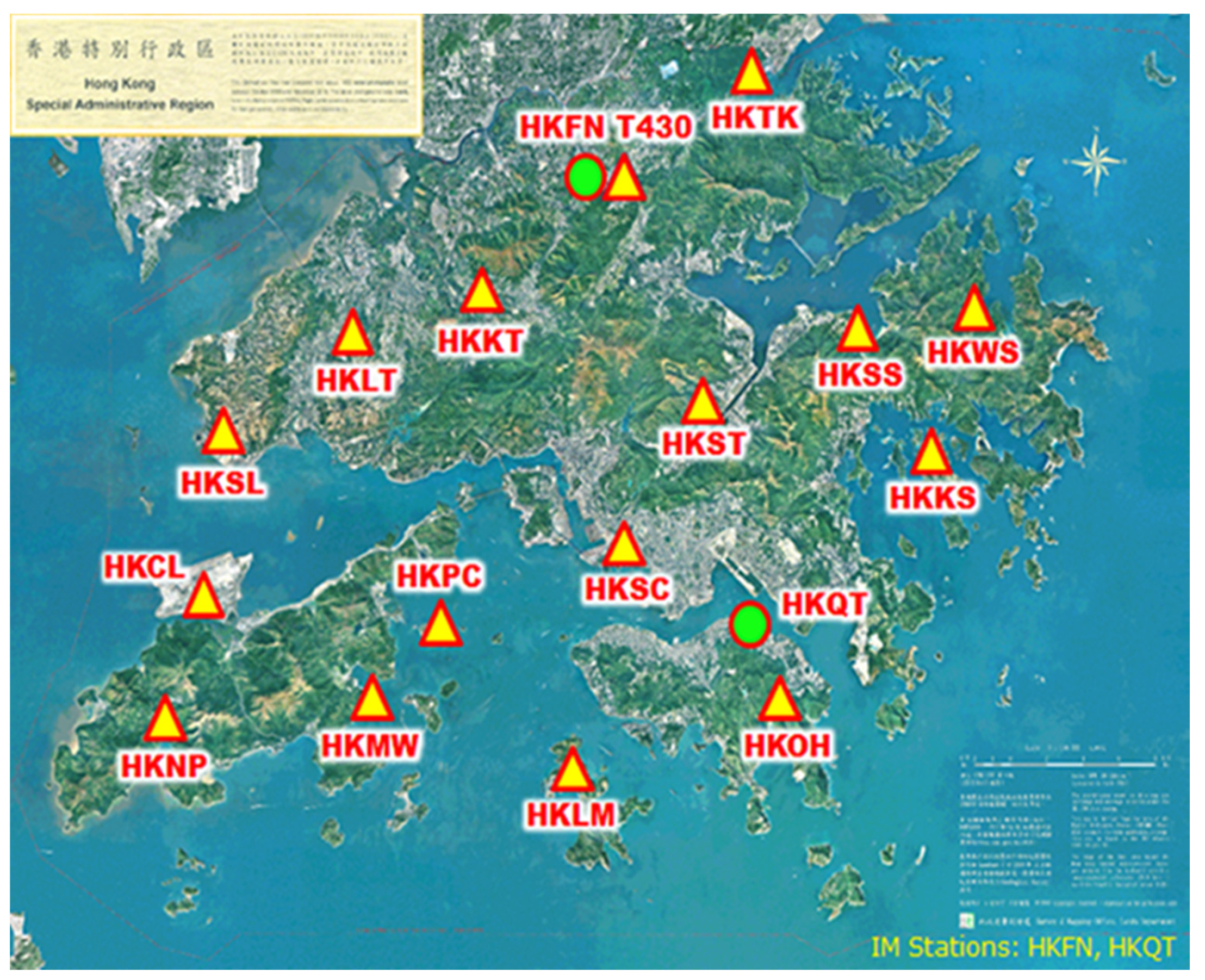
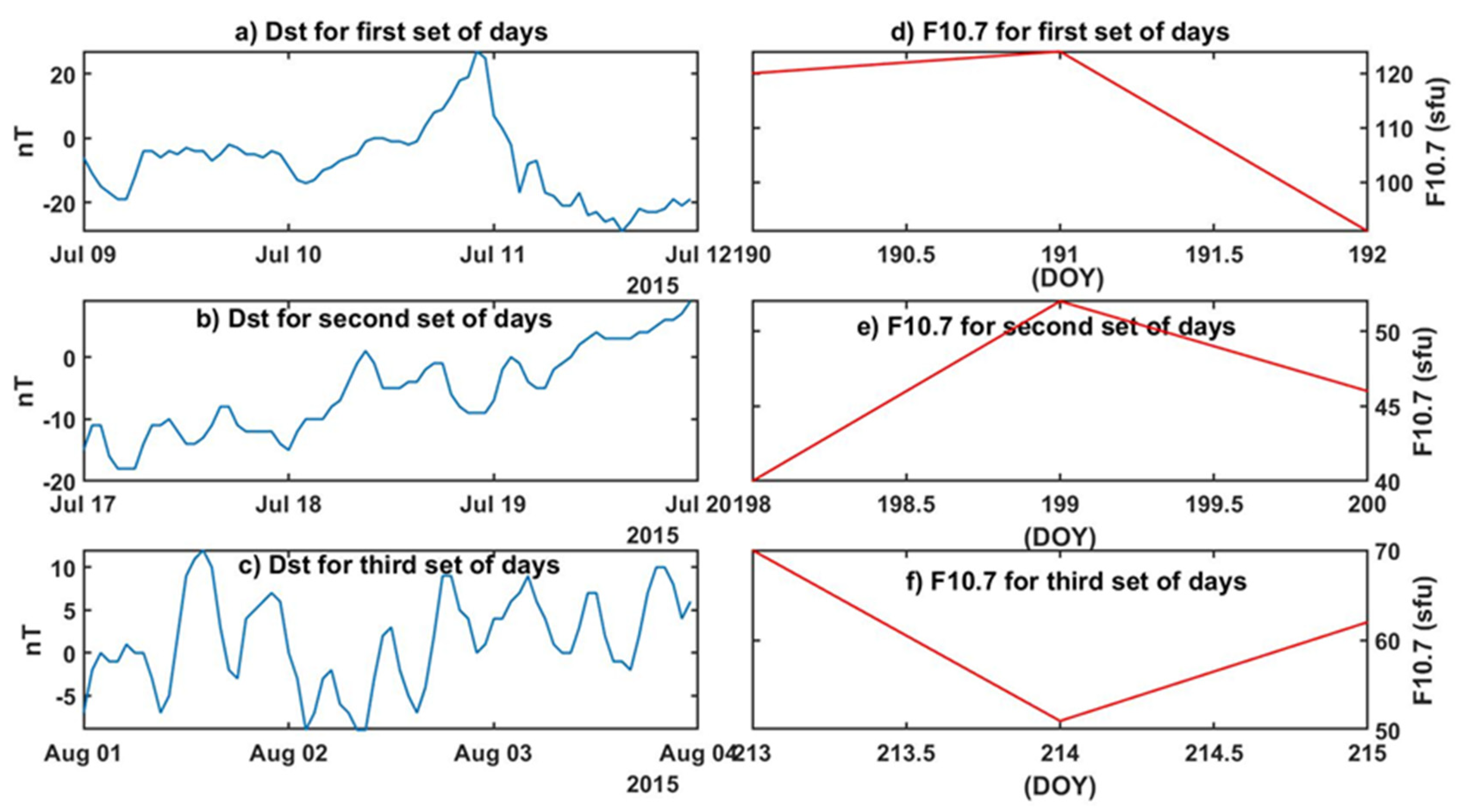

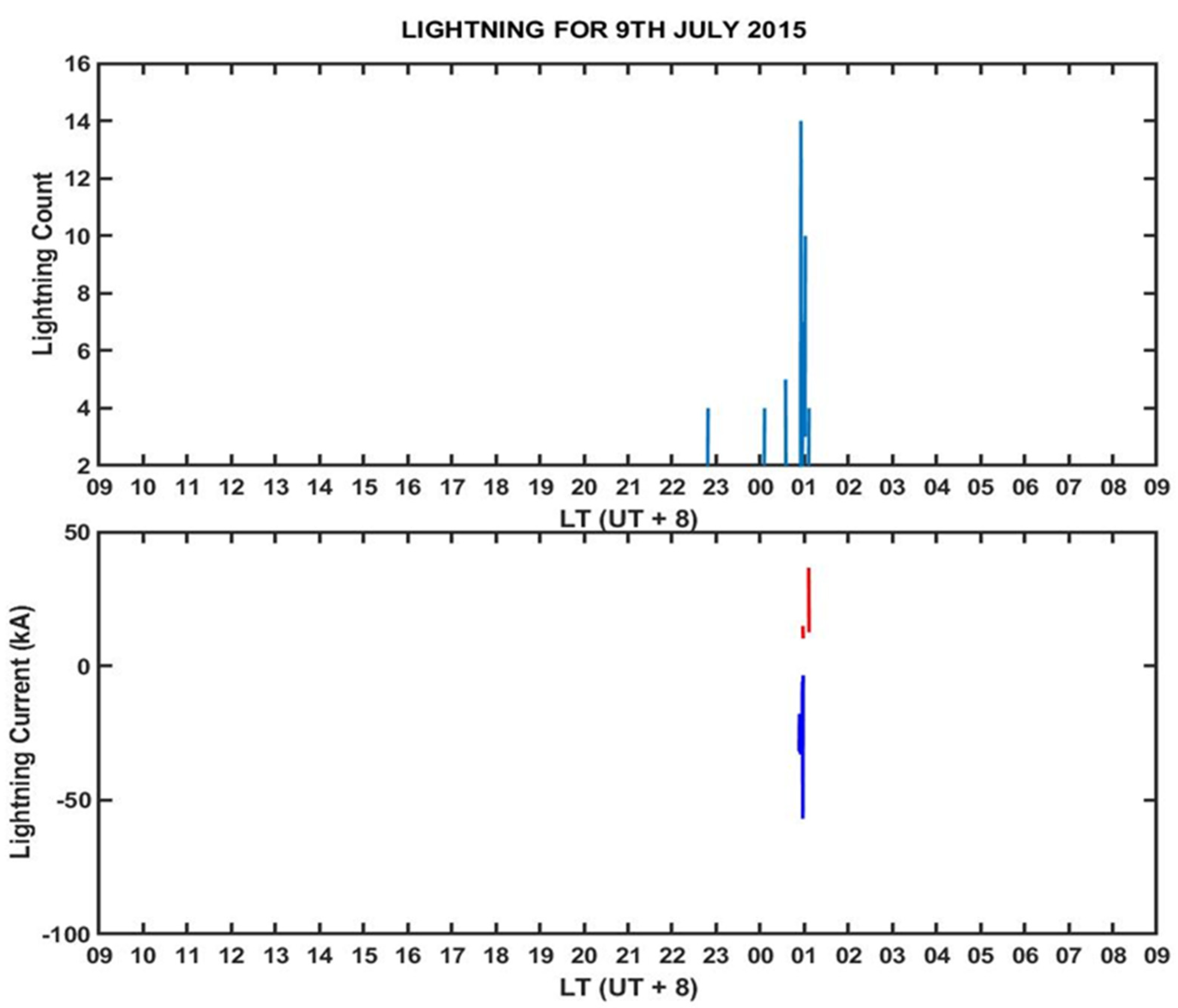

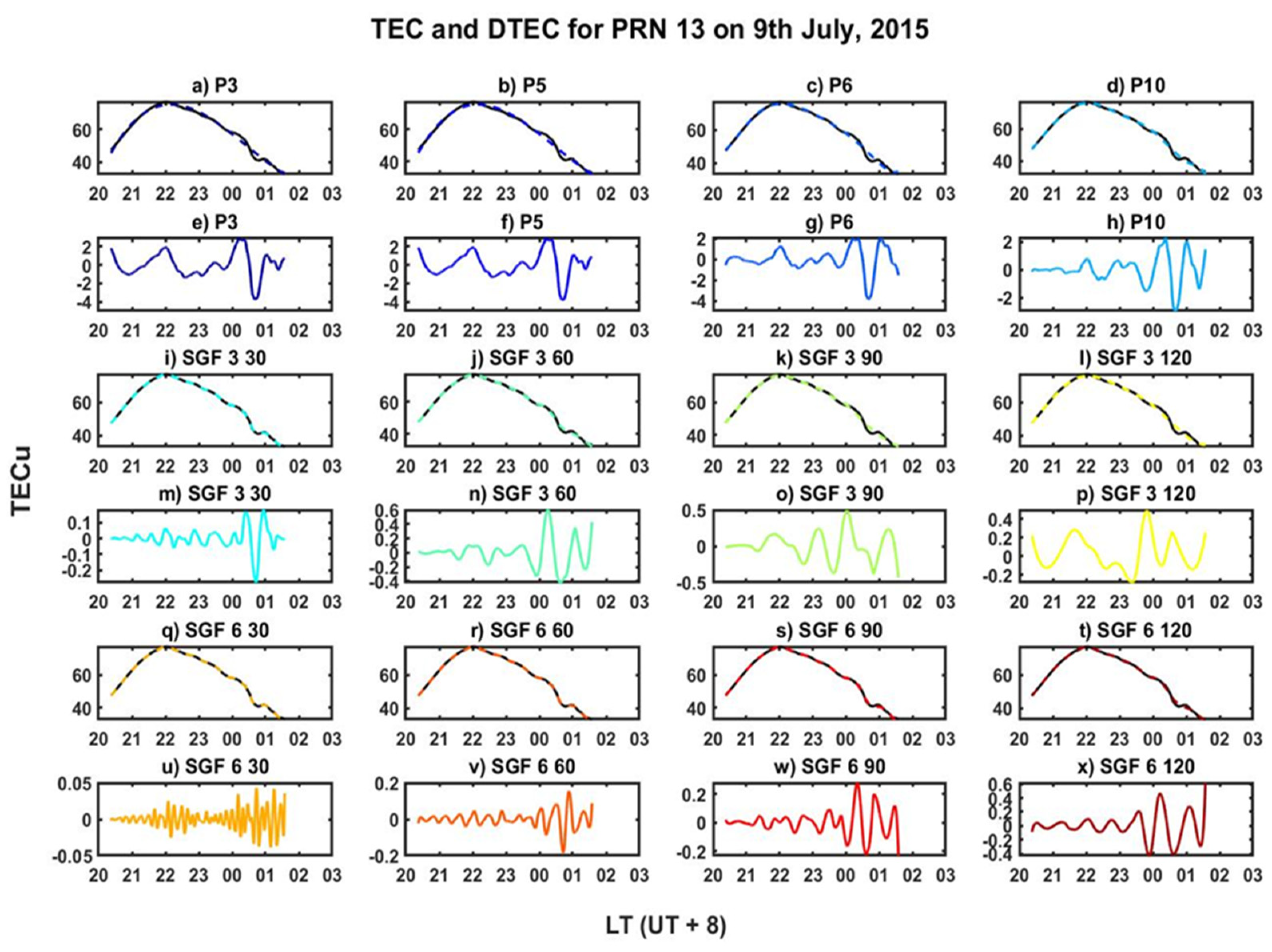
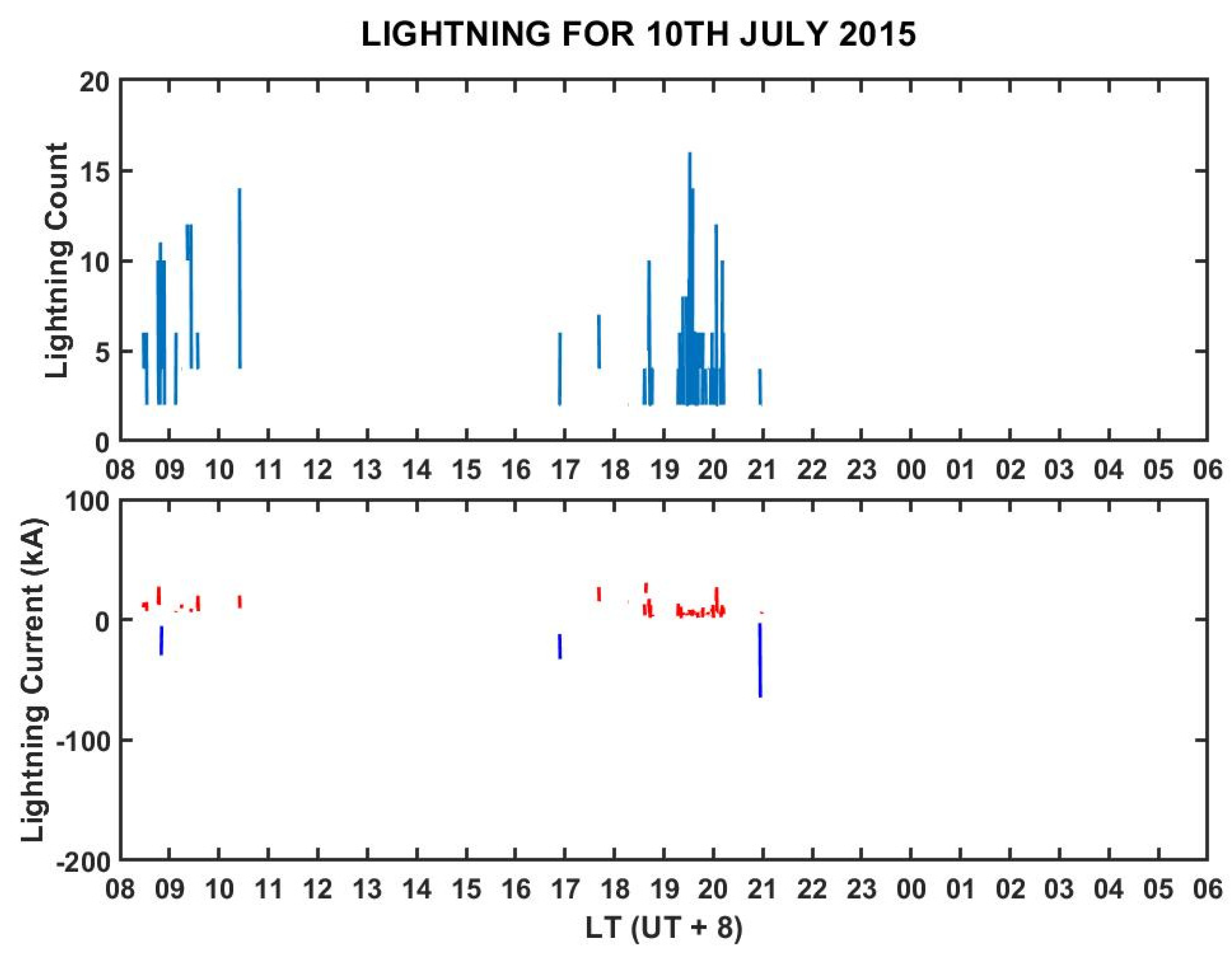

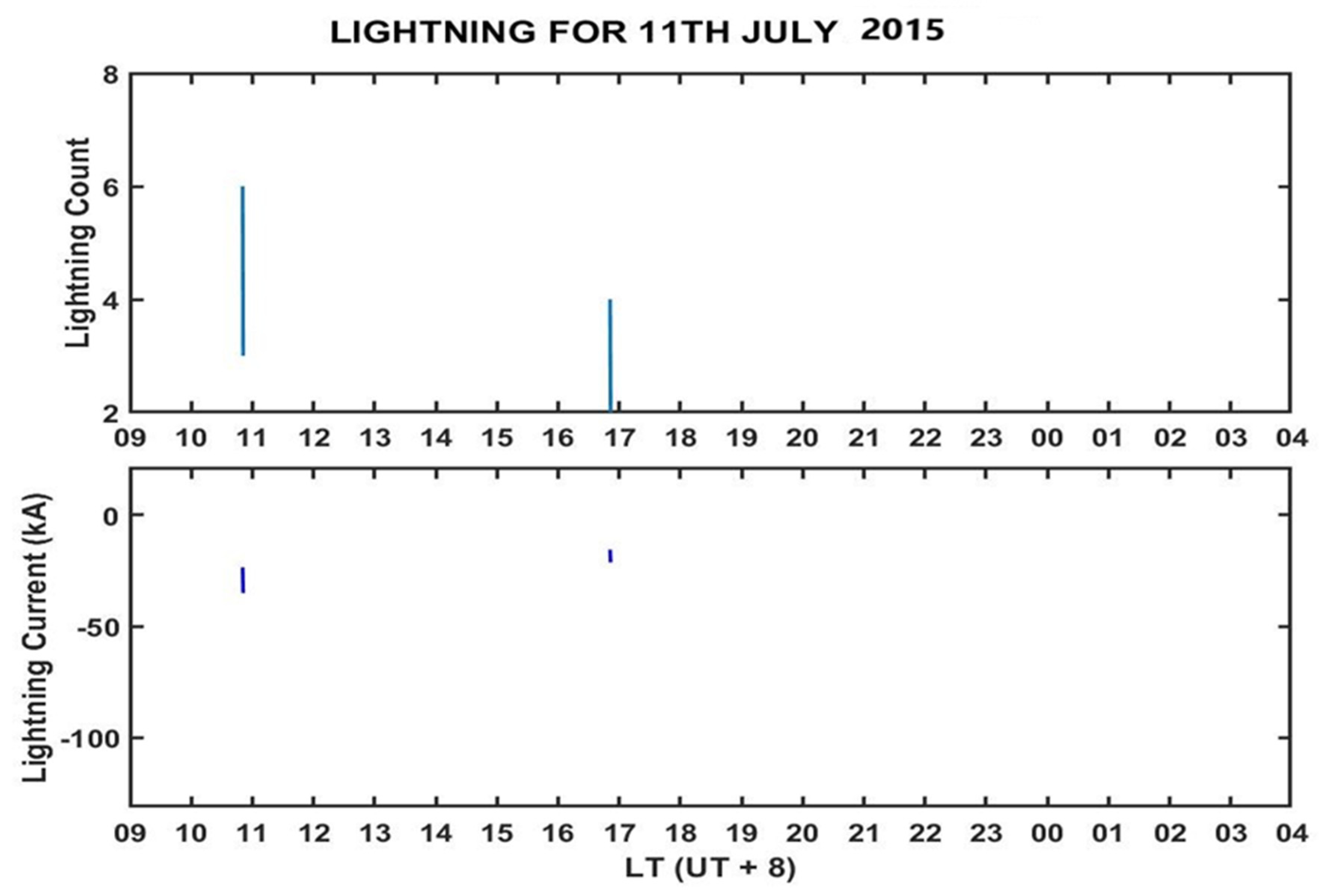
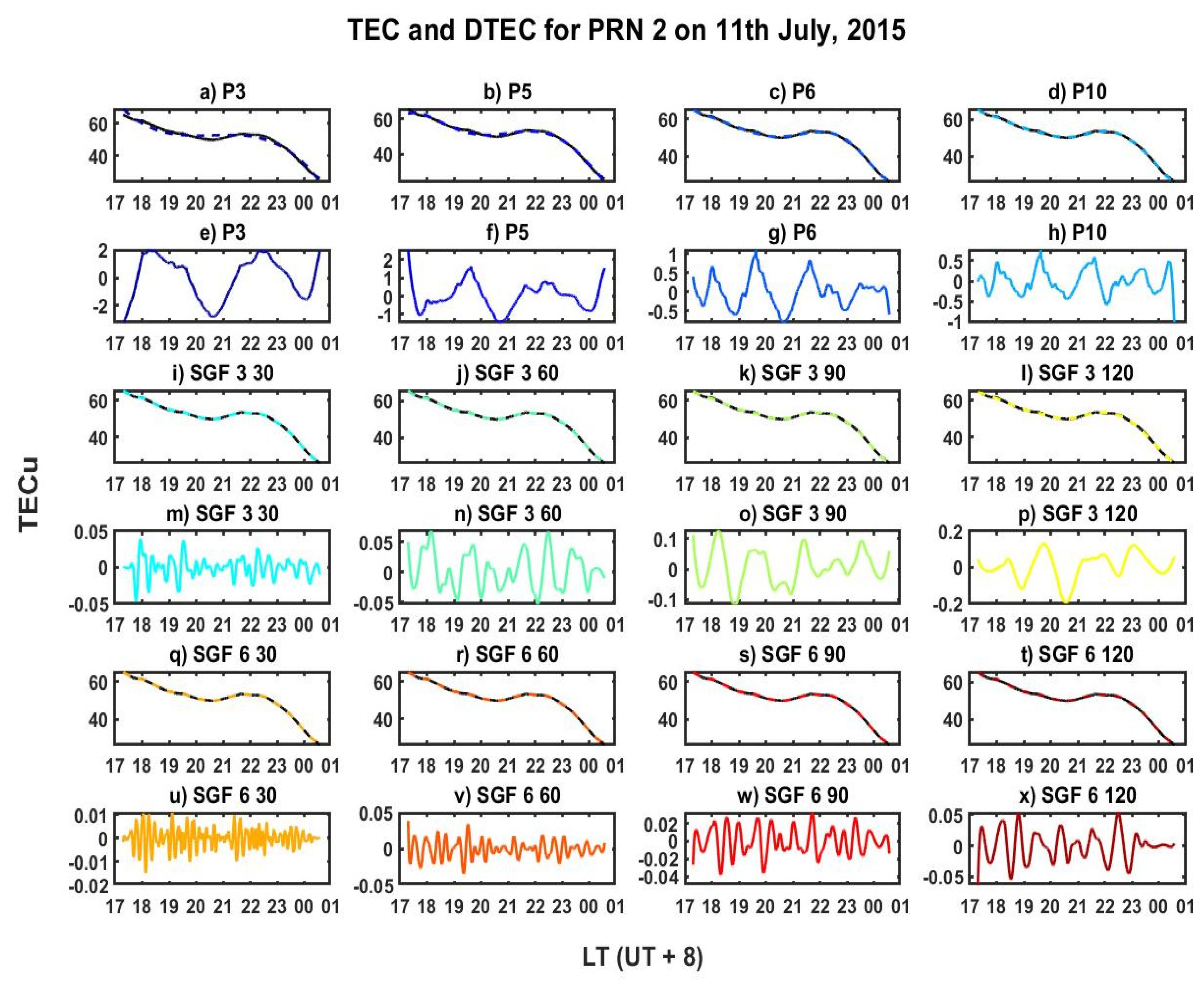
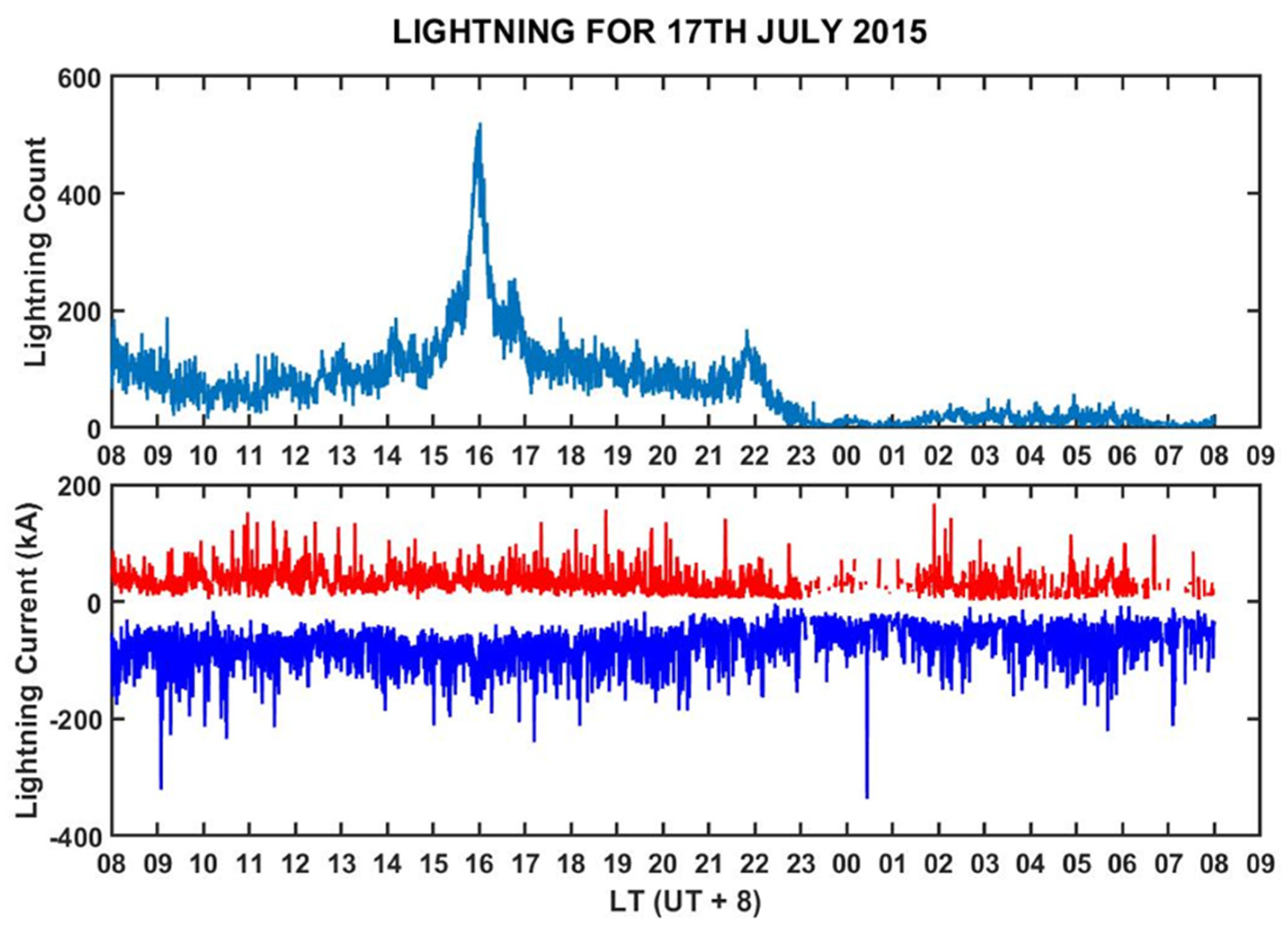
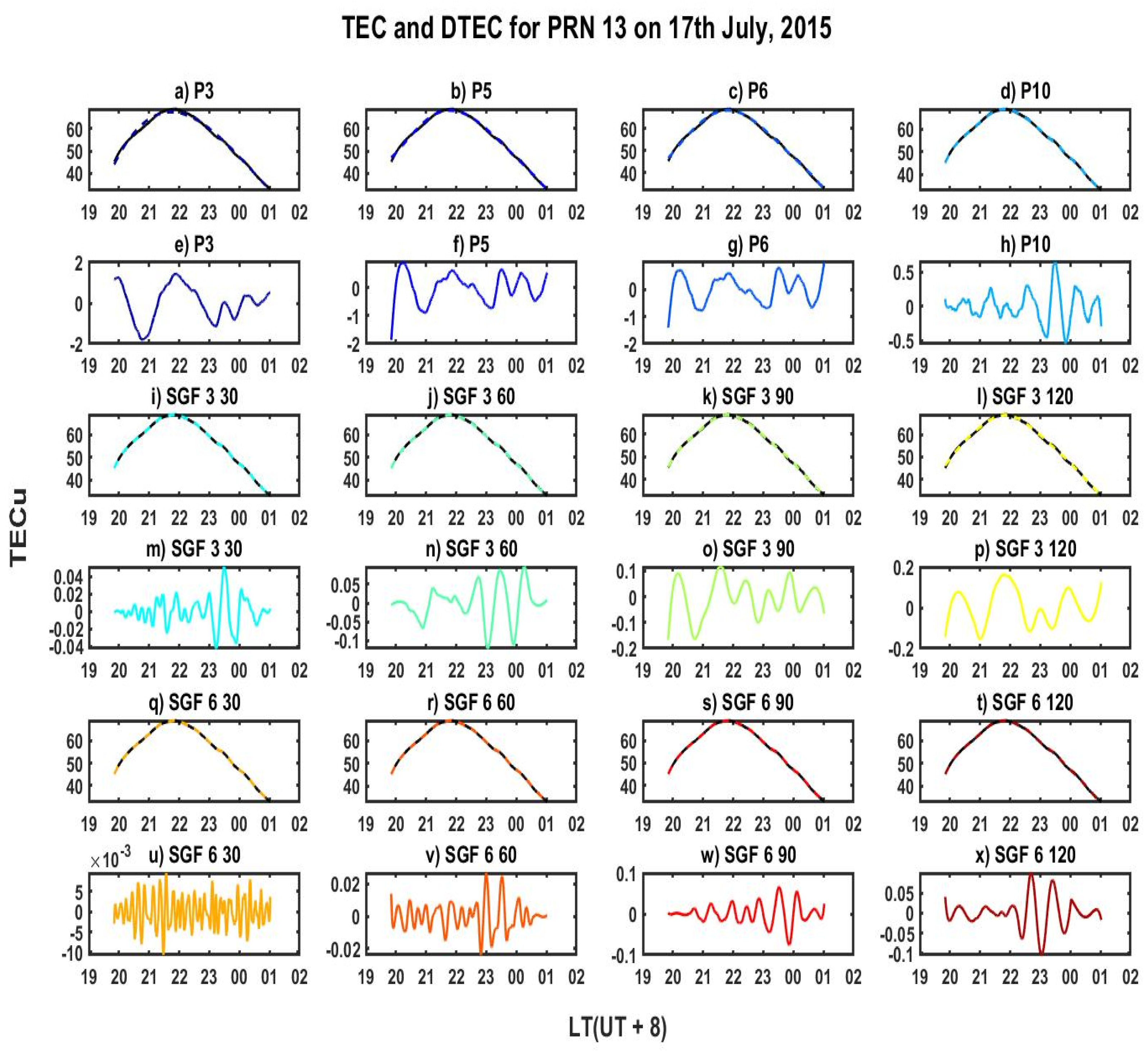
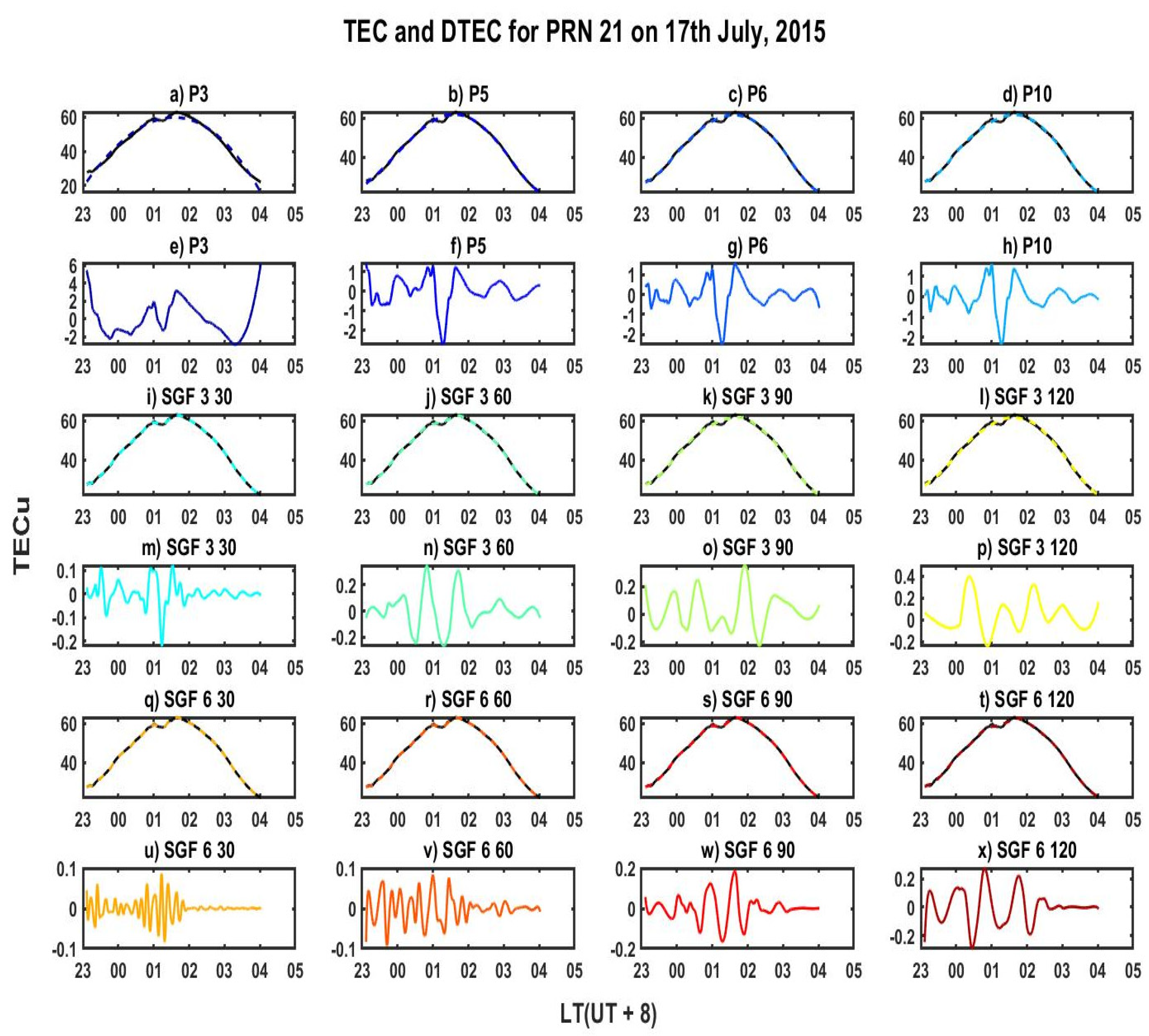
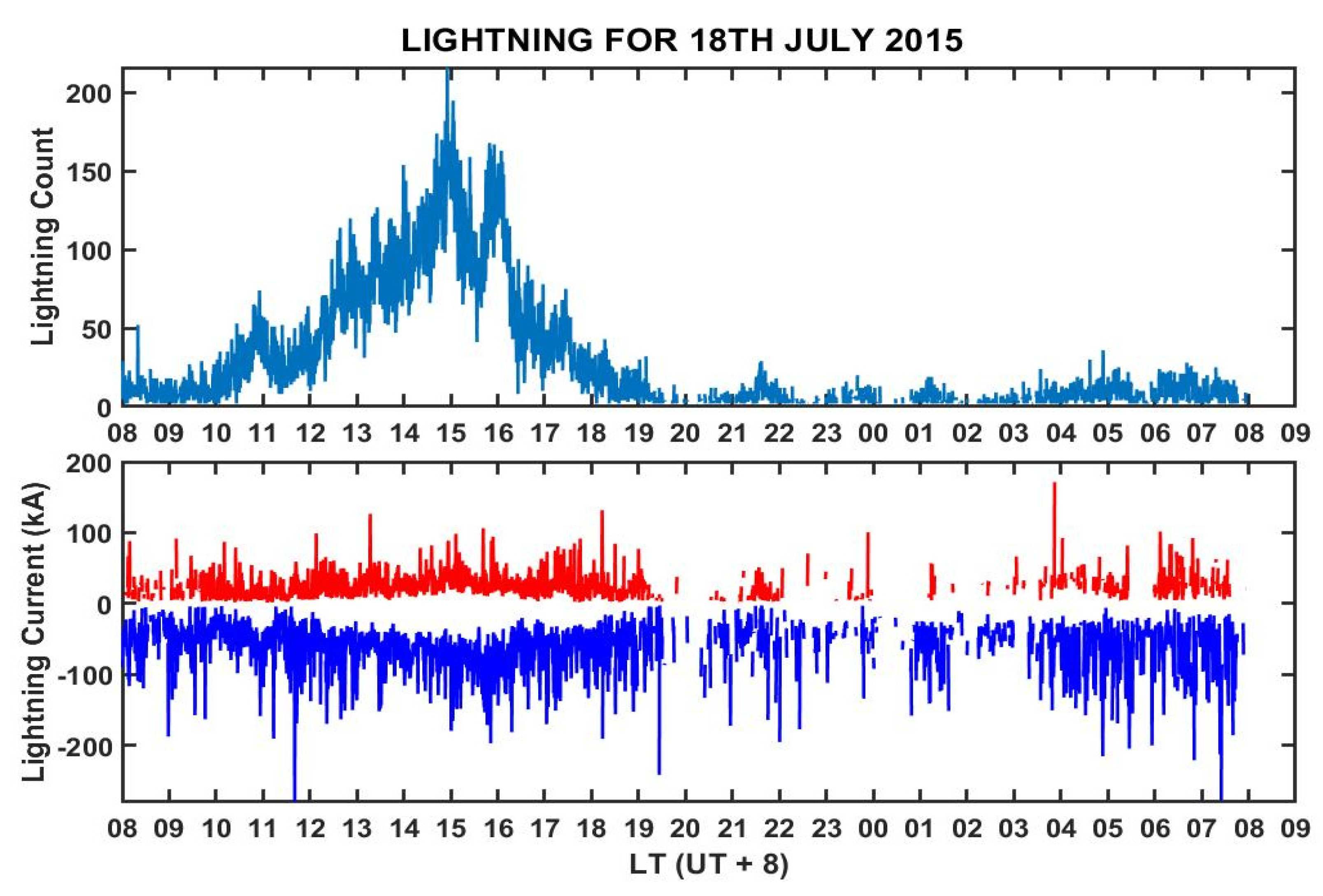

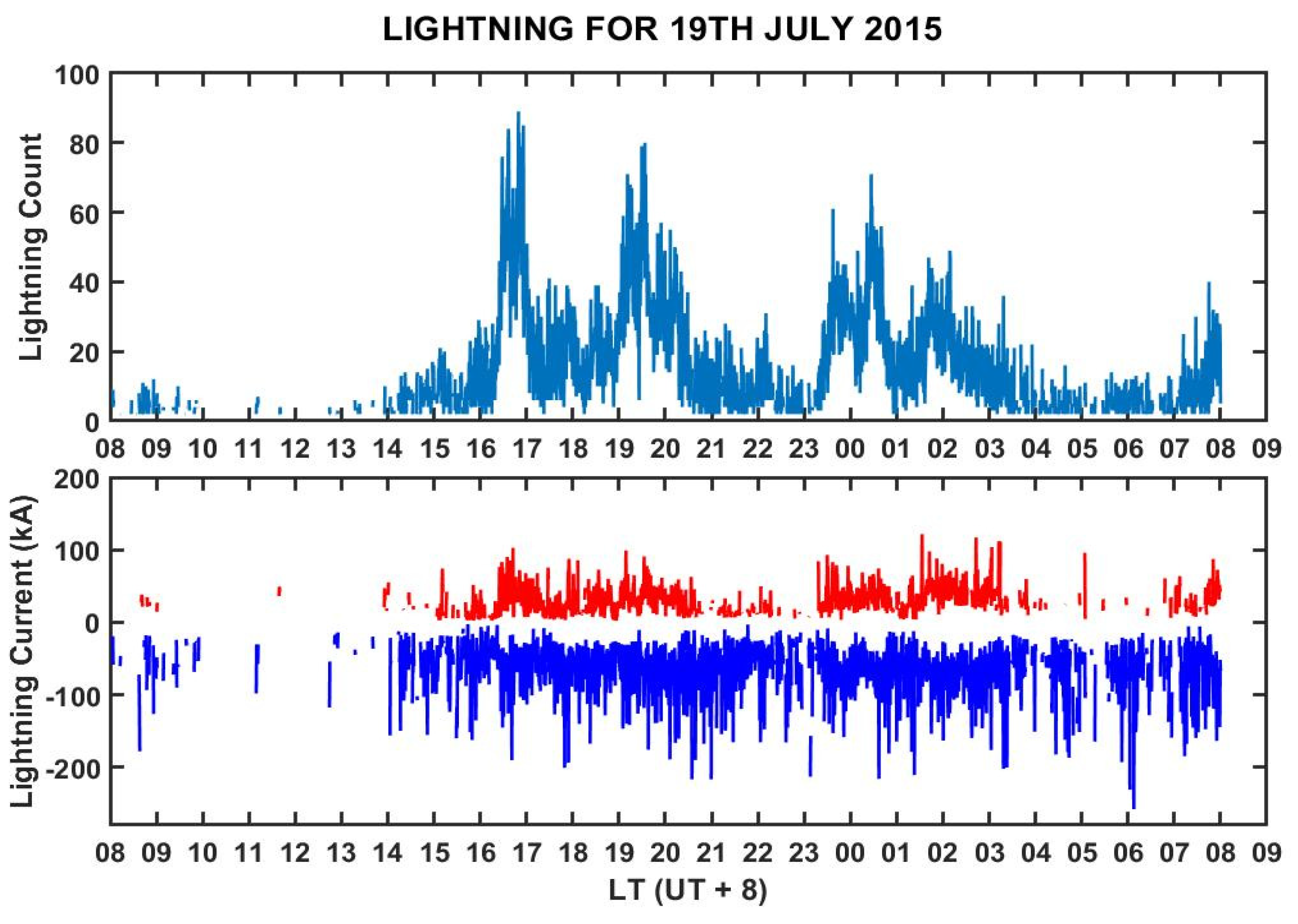

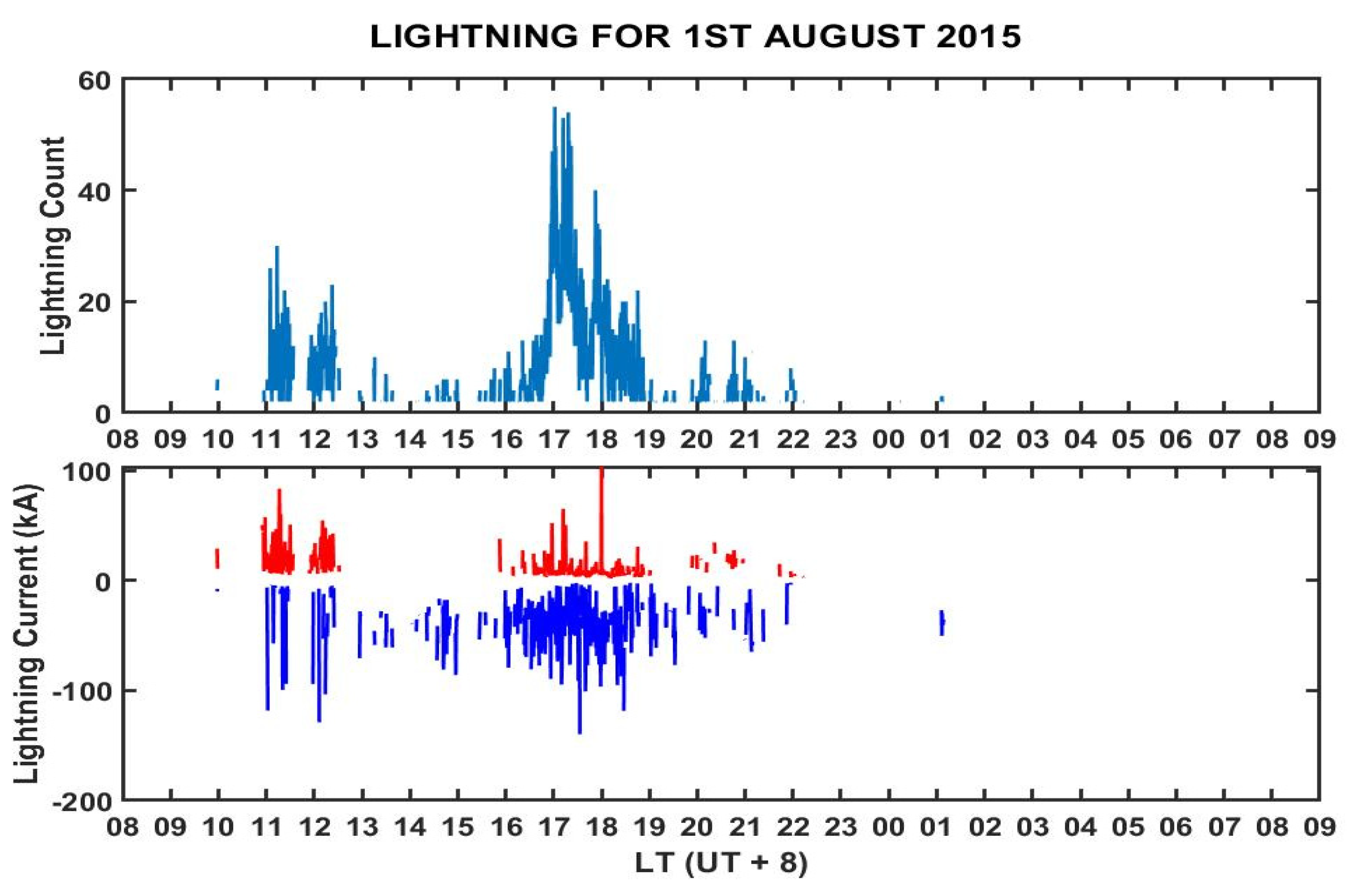
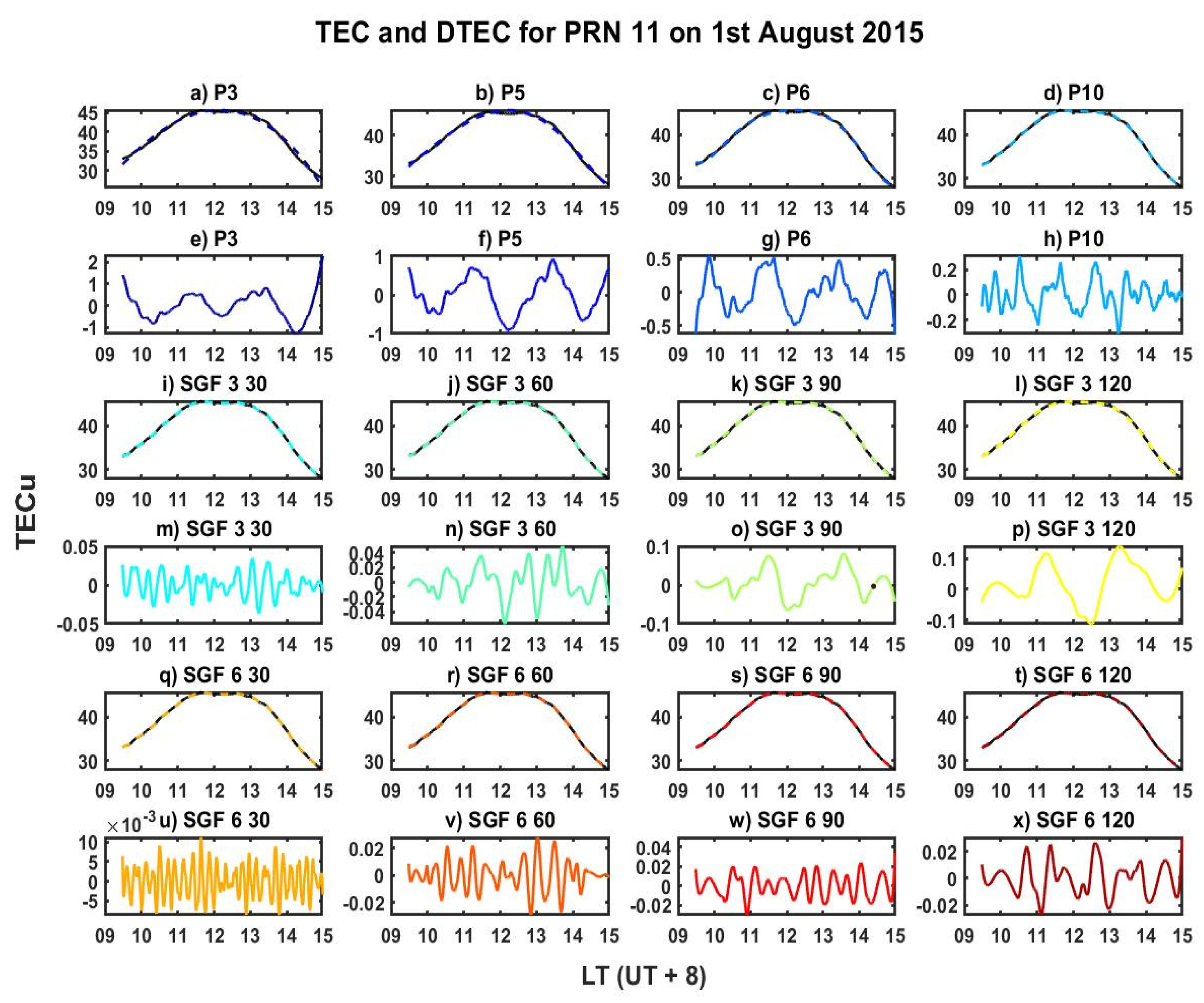
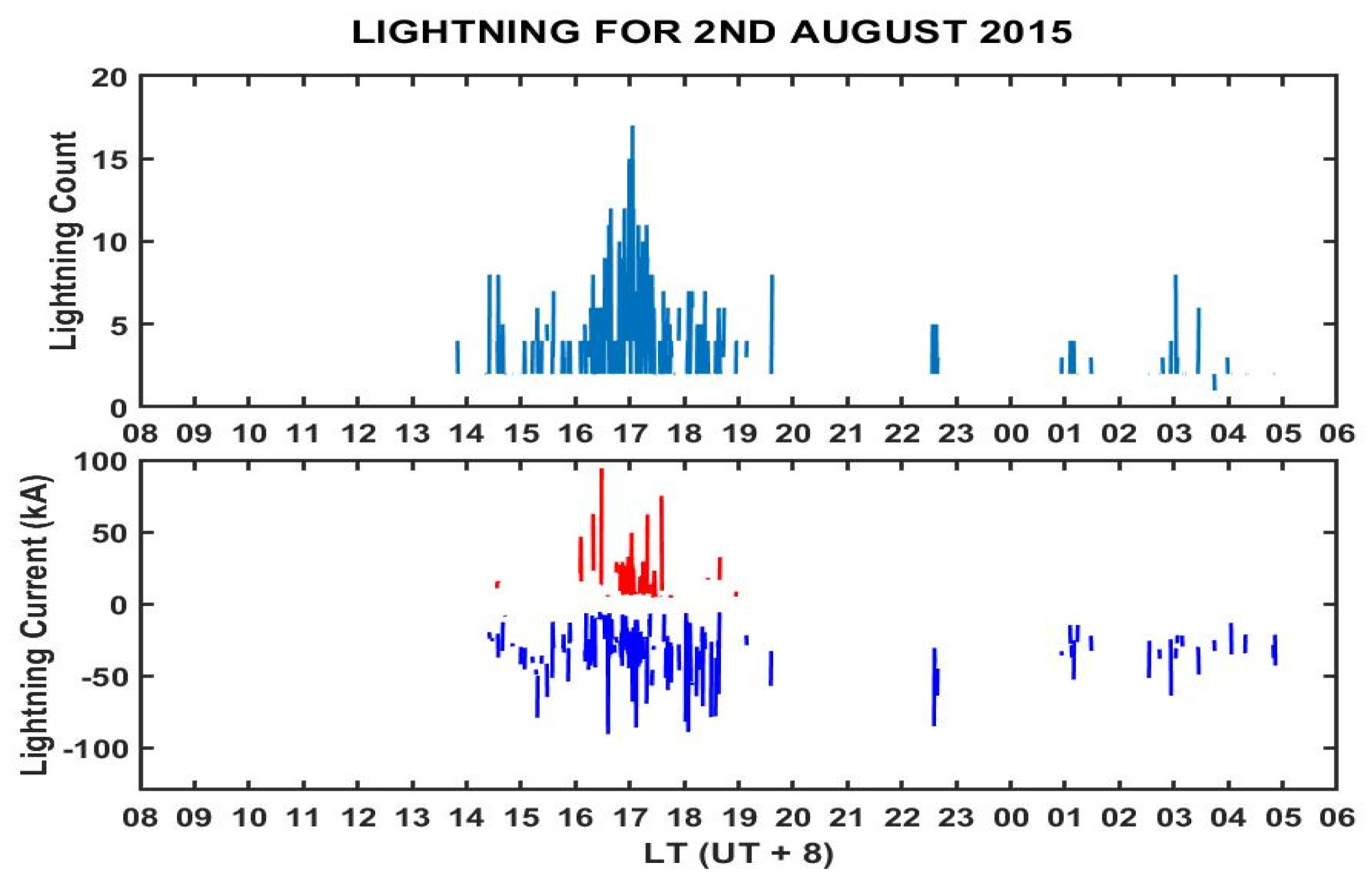
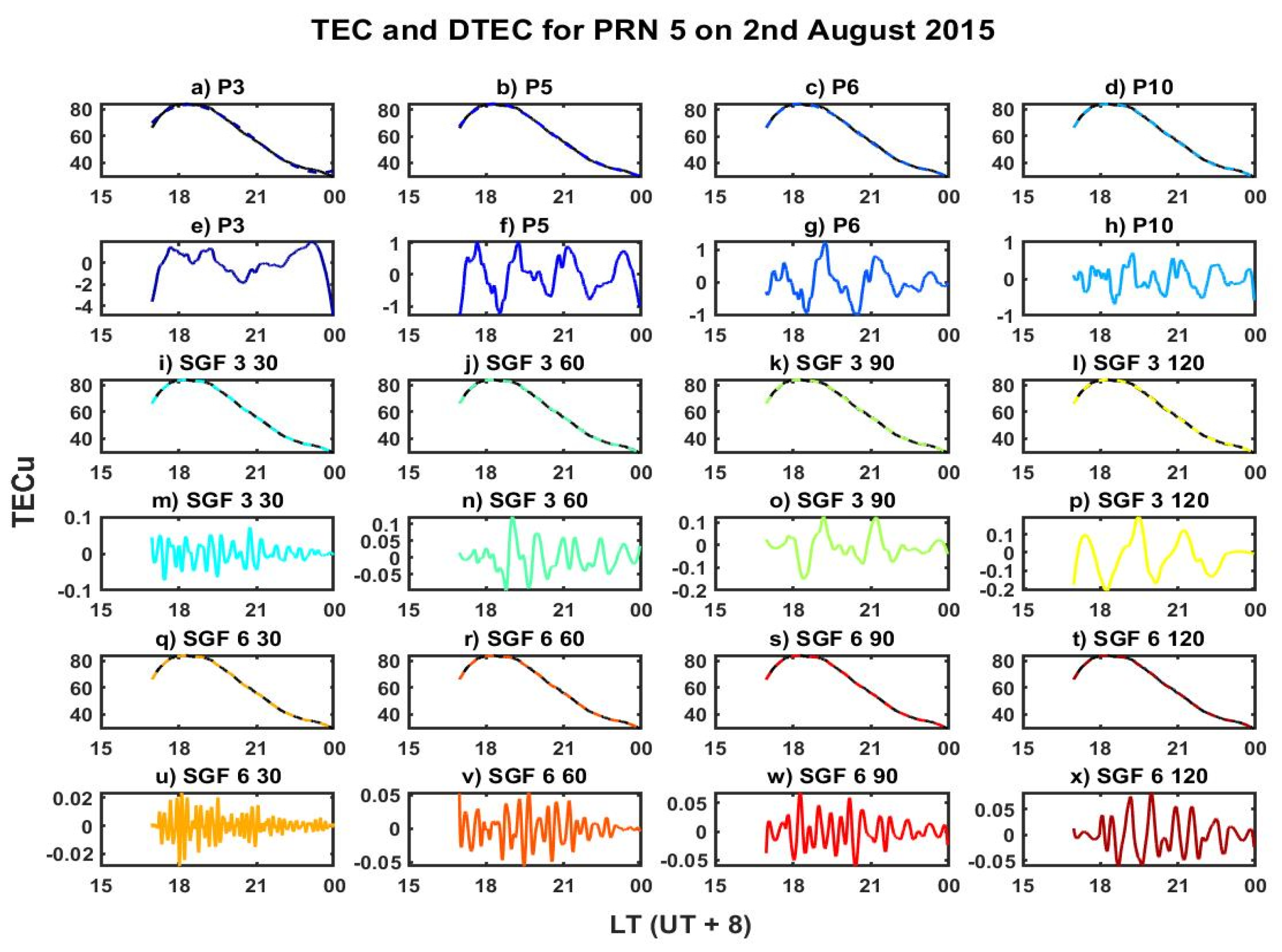
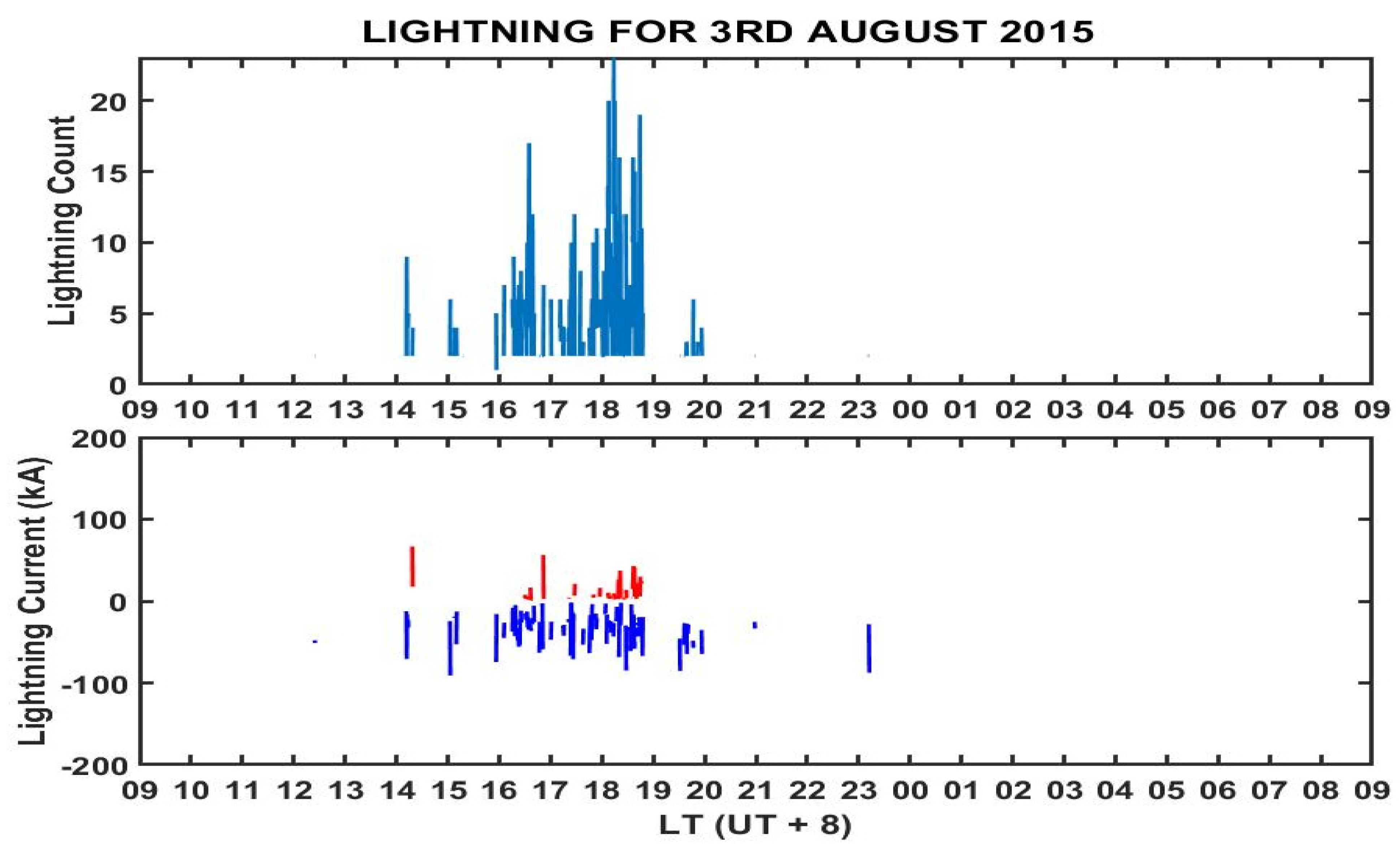
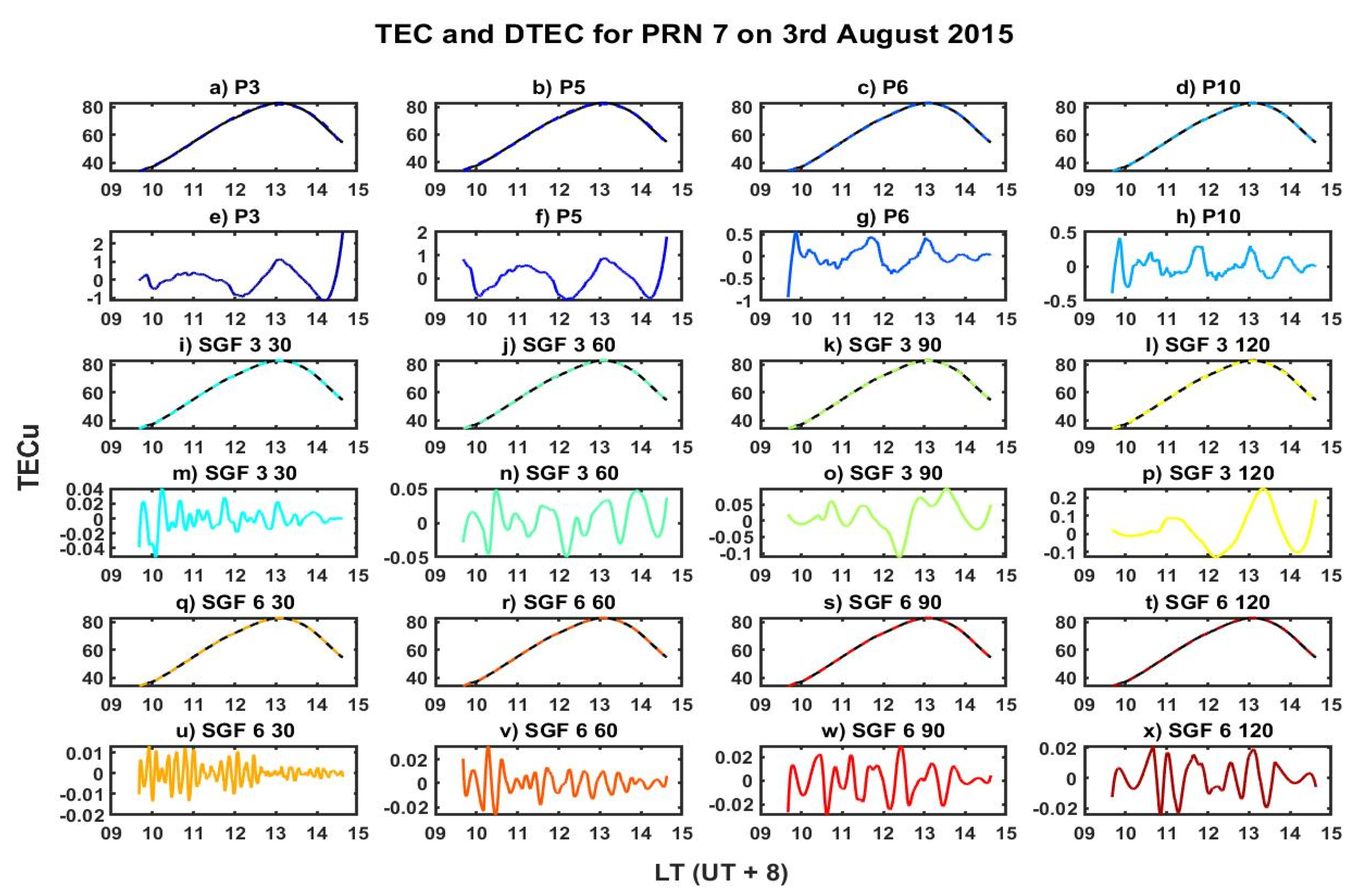
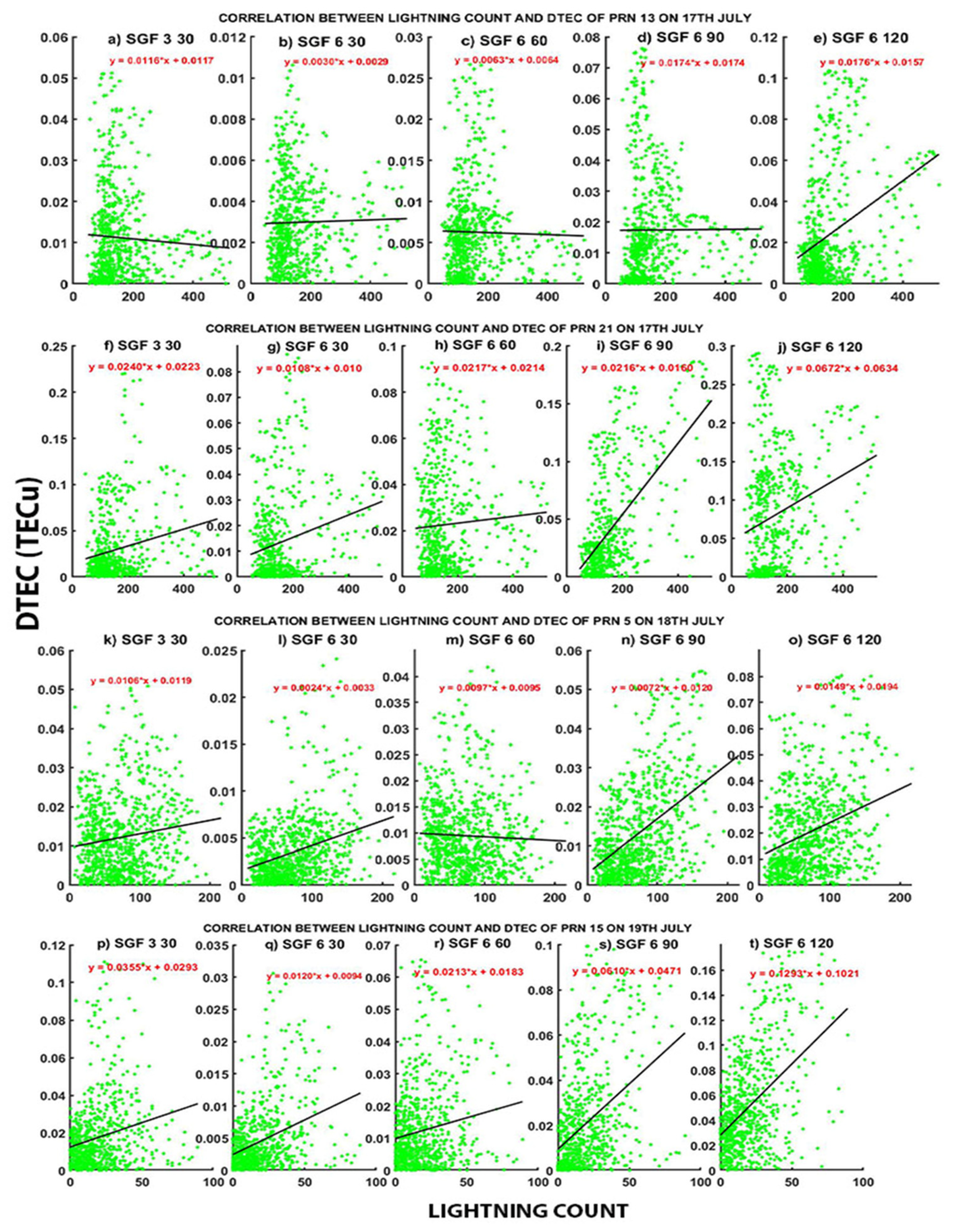
| Savitzky–Golay | ||||
|---|---|---|---|---|
| Order | Window (min) | |||
| 3 | 30 | 60 | 90 | 120 |
| 6 | 30 | 60 | 90 | 120 |
| Polynomial | ||||
| Order | 3 | 5 | 6 | 10 |
| Day/DTEC Method | P3 | P5 | P6 | P10 | sgf_3_30 | sgf_3_60 | sgf_3_90 | sgf_3_120 | sgf_6_30 | sgf_6_60 | sgf_6_90 | sgf_6_120 | |
|---|---|---|---|---|---|---|---|---|---|---|---|---|---|
| First set of days | 9th July | R | R | R | R | R | R | R | R | R | R | R | R |
| 10th July | R | R | R | R | R | R | R | R | R | R | R | R | |
| 11th July | R | R | R | R | R | R | R | R | R | R | R | R | |
| Second set of days | 17th July | D | D | D | D | D | D | D | D | D | D | D | D |
| 18th July | ND | ND | ND | D | D | D | D | D | D | D | D | D | |
| 19th July | - | D | D | D | D | D | D | D | D | D | D | D | |
| Third set of days | 1st August | R | R | R | R | R | R | R | R | R | R | R | R |
| 2nd August | R | R | R | R | R | R | R | R | R | R | R | R | |
| 3rd August | R | R | R | R | R | R | R | R | R | R | R | R | |
| CORRELATION COEFFICIENT | P-VALUE | |||||||
|---|---|---|---|---|---|---|---|---|
| DTEC Method/Satellite | 17th July (13) | 17th July (21) | 18th July (5) | 19th July (15) | 17th July (13) | 17th July (21) | 18th July (5) | 19th July (15) |
| sgf_3_30 | −0.0532432 | 0.212518 | 0.1380252 | 0.2172065 | 0.1844358 | 1.837E-07 | 6.041E-05 | 2.313E-09 |
| sgf_6_30 | 0.0205577 | 0.2196998 | 0.3005218 | 0.3456595 | 0.6085514 | 6.823E-08 | 5.672E-19 | 3.204E-22 |
| sgf_6_60 | −0.0195246 | 0.0597396 | −0.0388213 | 0.1613585 | 0.6266822 | 0.1469133 | 0.2613414 | 1.015E-05 |
| sgf_6_90 | 0.0040953 | 0.5853365 | 0.465207 | 0.4095069 | 0.9187456 | 1.245E-55 | 2.789E-46 | 2.492E-31 |
| sgf_6_120 | 0.34839 | 0.2449198 | 0.3050079 | 0.4778427 | 3.23E-19 | 1.603E-09 | 1.599E-19 | 1.554E-43 |
Publisher’s Note: MDPI stays neutral with regard to jurisdictional claims in published maps and institutional affiliations. |
© 2021 by the authors. Licensee MDPI, Basel, Switzerland. This article is an open access article distributed under the terms and conditions of the Creative Commons Attribution (CC BY) license (https://creativecommons.org/licenses/by/4.0/).
Share and Cite
Osei-Poku, L.; Tang, L.; Chen, W.; Mingli, C. Evaluating Total Electron Content (TEC) Detrending Techniques in Determining Ionospheric Disturbances during Lightning Events in A Low Latitude Region. Remote Sens. 2021, 13, 4753. https://doi.org/10.3390/rs13234753
Osei-Poku L, Tang L, Chen W, Mingli C. Evaluating Total Electron Content (TEC) Detrending Techniques in Determining Ionospheric Disturbances during Lightning Events in A Low Latitude Region. Remote Sensing. 2021; 13(23):4753. https://doi.org/10.3390/rs13234753
Chicago/Turabian StyleOsei-Poku, Louis, Long Tang, Wu Chen, and Chen Mingli. 2021. "Evaluating Total Electron Content (TEC) Detrending Techniques in Determining Ionospheric Disturbances during Lightning Events in A Low Latitude Region" Remote Sensing 13, no. 23: 4753. https://doi.org/10.3390/rs13234753
APA StyleOsei-Poku, L., Tang, L., Chen, W., & Mingli, C. (2021). Evaluating Total Electron Content (TEC) Detrending Techniques in Determining Ionospheric Disturbances during Lightning Events in A Low Latitude Region. Remote Sensing, 13(23), 4753. https://doi.org/10.3390/rs13234753





